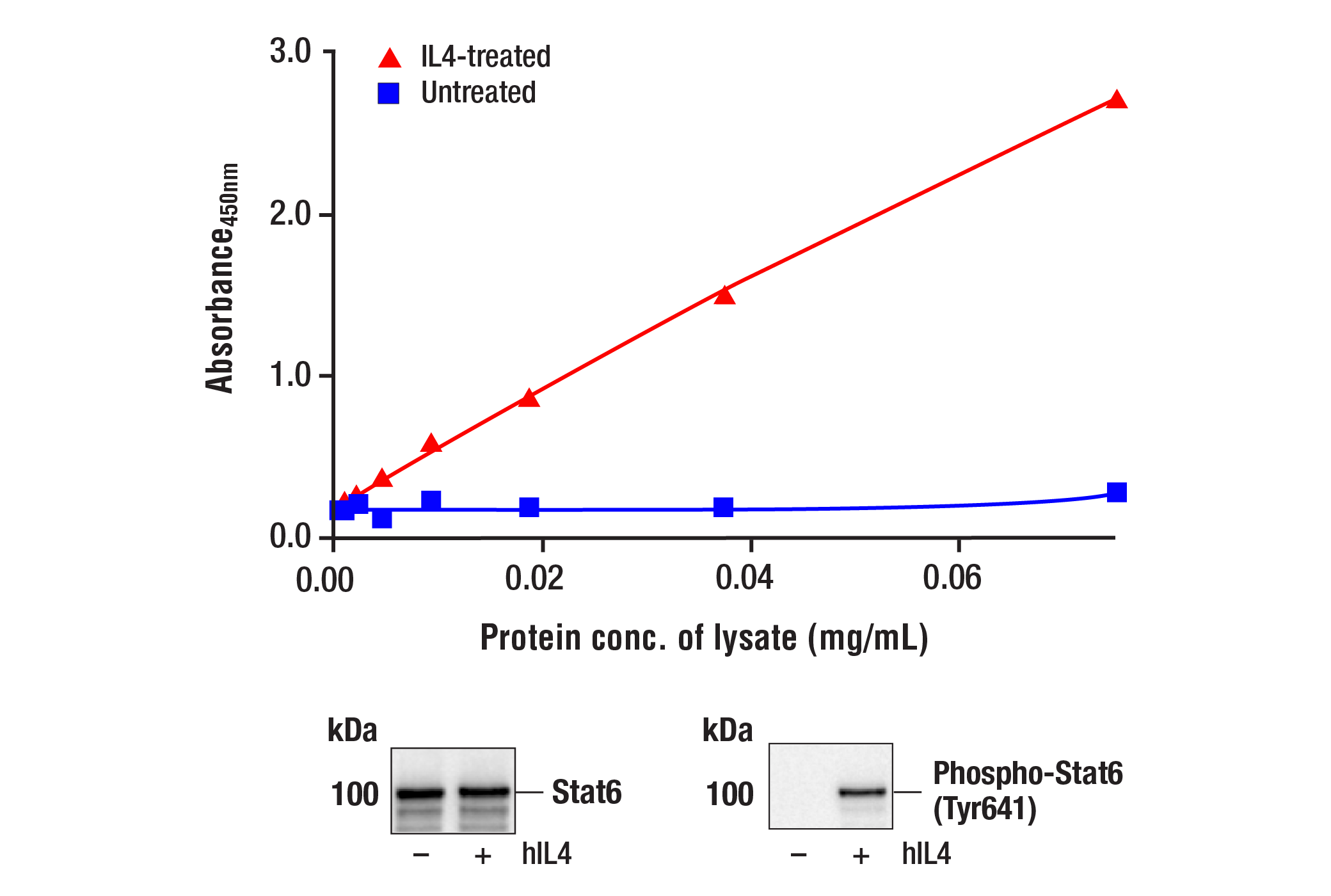| Product Includes | Product # | Quantity | Color | Storage Temp |
|---|---|---|---|---|
| P-Stat6 (Tyr641) Rabbit mAb Coated Microwell | 99714 | 96 tests |
|
+4C |
| Stat6 Rabbit Detection mAb | 47131 | 1 ea |
|
+4C |
| HRP Diluent | 13515 | 5.5 ml |
|
+4C |
| TMB Substrate | 7004 | 11 ml |
|
+4C |
| STOP Solution | 7002 | 11 ml |
|
+4C |
| Sealing Tape | 54503 | 2 ea |
|
+4C |
| ELISA Wash Buffer (20X) | 9801 | 25 ml |
|
+4C |
| Cell Lysis Buffer (10X) | 9803 | 15 ml |
|
-20C |
*The microwell plate is supplied as 12 8-well modules - Each module is designed to break apart for 8 tests.
Description
The rapid protocol (RP) PathScan® RP Phospho-Stat6 (Tyr641) Sandwich ELISA Kit is a solid phase sandwich enzyme-linked immunosorbent assay (ELISA) that detects endogenous levels of Stat6 protien phosphorylated at Tyr641 in a reduced assay time of 1.5 hours. Incubation of cell lysates and detection antibody on the coated microwell plate forms a sandwich with Stat6 protien phosphorylated at Tyr641 in a single step. The plate is then extensively washed and TMB reagent is added for signal development. The magnitude of absorbance for the developed color is proportional to the quantity of Stat6 protien phosphorylated at Tyr641. Learn more about all your ELISA kit options here.
*Antibodies in this kit are custom formulations specific to kit.
Specificity/Sensitivity
Background
Upon activation by Janus kinases, Stat6 translocates to the nucleus where it regulates cytokine-induced gene expression. Stat6 is activated via phosphorylation at Tyr641 and is required for responsiveness to IL-4 and IL-13 (1-4). In addition, Stat6 is activated by IFN-α in B cells, where it forms transcriptionally active complexes with Stat2 and p48 (5,6). Protein phosphatase 2A is also involved in regulation of IL-4-mediated Stat6 signaling (7).
- Nelms, K. et al. (1999) Ann. Rev. Immunol. 17, 701-738.
- Malabarba, M.G. et al. (1996) Biochem. J. 319, 865-872.
- Hou, J. et al. (1994) Science 265, 1701-1706.
- Quelle, F.W. et al. (1995) Mol. Cell. Biol. 15, 3336-3343.
- Takeda, K. et al. (1996) Nature 380, 627-630.
- Gupta, S. et al. (1999) J. Immunol. 163, 3834-3841.
- Woetmann, A. et al. (2003) J. Biol. Chem. 278, 2787-2791.
Background References
Cross-Reactivity Key
H: human M: mouse R: rat Hm: hamster Mk: monkey Vir: virus Mi: mink C: chicken Dm: D. melanogaster X: Xenopus Z: zebrafish B: bovine Dg: dog Pg: pig Sc: S. cerevisiae Ce: C. elegans Hr: horse GP: Guinea Pig Rab: rabbit All: all species expected
Trademarks and Patents
Limited Uses
Except as otherwise expressly agreed in a writing signed by a legally authorized representative of CST, the following terms apply to Products provided by CST, its affiliates or its distributors. Any Customer's terms and conditions that are in addition to, or different from, those contained herein, unless separately accepted in writing by a legally authorized representative of CST, are rejected and are of no force or effect.
Products are labeled with For Research Use Only or a similar labeling statement and have not been approved, cleared, or licensed by the FDA or other regulatory foreign or domestic entity, for any purpose. Customer shall not use any Product for any diagnostic or therapeutic purpose, or otherwise in any manner that conflicts with its labeling statement. Products sold or licensed by CST are provided for Customer as the end-user and solely for research and development uses. Any use of Product for diagnostic, prophylactic or therapeutic purposes, or any purchase of Product for resale (alone or as a component) or other commercial purpose, requires a separate license from CST. Customer shall (a) not sell, license, loan, donate or otherwise transfer or make available any Product to any third party, whether alone or in combination with other materials, or use the Products to manufacture any commercial products, (b) not copy, modify, reverse engineer, decompile, disassemble or otherwise attempt to discover the underlying structure or technology of the Products, or use the Products for the purpose of developing any products or services that would compete with CST products or services, (c) not alter or remove from the Products any trademarks, trade names, logos, patent or copyright notices or markings, (d) use the Products solely in accordance with CST Product Terms of Sale and any applicable documentation, and (e) comply with any license, terms of service or similar agreement with respect to any third party products or services used by Customer in connection with the Products.
